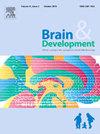Risk factors for sedation and MRI failure in children with neurodevelopmental disorders undergoing head MRI with oral triclofos sodium and/or rectal chloral hydrate
IF 1.4
4区 医学
Q4 CLINICAL NEUROLOGY
引用次数: 0
Abstract
Background
Head magnetic resonance imaging (MRI) is of critical importance in the diagnosis and management of neurodevelopmental disorders. However, the use of sedation in affected children can present a significant challenge.
Aims
To identify the factors associated with sedation and MRI failure in children with neurodevelopmental disorders undergoing head MRI with oral triclofos sodium or rectal chloral hydrate.
Methods
This retrospective study analyzed 215 MRI sessions of children with neurodevelopmental disorders from January 2020 to December 2021. Sedation was administered via oral triclofos sodium or rectal chloral hydrate. Multivariate logistic regression was used to determine the factors associated with sedation failure and MRI failure.
Results
The sedation failure rate was 38.1 % (82/215). Factors significantly associated with sedation failure were older age (odds ratio [OR] 1.59, 95 % confidence interval [CI] 1.30–1.95, p < 0.001) and stranger anxiety (OR 4.07, 95 % CI 1.95–8.49, p < 0.001). The age cut-off for increased sedation failure risk was 4.0 years (p < 0.01). The MRI failure rate was 21.9 % (47/215), associated with autism spectrum disorder (ASD) diagnosis (OR 19.00, 95 % CI 2.43–149.00, p < 0.01), stranger anxiety (OR 3.66, 95 % CI 1.62–8.24, p < 0.01), and place anxiety (OR 3.18, 95 % CI 1.33–7.57, p < 0.01).
Conclusions
Older age and stranger anxiety are significant risk factors for sedation failure, while ASD diagnosis, stranger anxiety, and place anxiety increase MRI failure risk in children with neurodevelopmental disorders undergoing head MRI.
神经发育障碍儿童口服三氯fos钠和/或直肠水合氯醛进行头部MRI时镇静和MRI失败的危险因素
背景:头部磁共振成像(MRI)在神经发育障碍的诊断和治疗中具有至关重要的意义。然而,在受影响的儿童中使用镇静可能会带来重大挑战。目的探讨神经发育障碍患儿口服三氯fos钠或直肠水合氯醛头部MRI时镇静和MRI失败的相关因素。方法回顾性分析2020年1月至2021年12月215次神经发育障碍儿童MRI检查结果。口服三氯氟氯钠或直肠水合氯醛给予镇静。采用多因素logistic回归来确定与镇静失败和MRI失败相关的因素。结果镇静失败率为38.1%(82/215)。与镇静失败显著相关的因素是年龄较大(优势比[OR] 1.59, 95%可信区间[CI] 1.30-1.95, p <;0.001)和陌生人焦虑(OR 4.07, 95% CI 1.95-8.49, p <;0.001)。镇静失败风险增加的年龄临界值为4.0岁(p <;0.01)。MRI失败率为21.9%(47/215),与自闭症谱系障碍(ASD)诊断相关(OR 19.00, 95% CI 2.43-149.00, p <;0.01),陌生人焦虑(OR 3.66, 95% CI 1.62-8.24, p <;0.01)和场所焦虑(OR 3.18, 95% CI 1.33-7.57, p <;0.01)。结论年龄和陌生人焦虑是镇静失败的重要危险因素,而ASD诊断、陌生人焦虑和场所焦虑增加了神经发育障碍儿童头部MRI镇静失败的风险。
本文章由计算机程序翻译,如有差异,请以英文原文为准。
求助全文
约1分钟内获得全文
求助全文
来源期刊

Brain & Development
医学-临床神经学
CiteScore
3.60
自引率
0.00%
发文量
153
审稿时长
50 days
期刊介绍:
Brain and Development (ISSN 0387-7604) is the Official Journal of the Japanese Society of Child Neurology, and is aimed to promote clinical child neurology and developmental neuroscience.
The journal is devoted to publishing Review Articles, Full Length Original Papers, Case Reports and Letters to the Editor in the field of Child Neurology and related sciences. Proceedings of meetings, and professional announcements will be published at the Editor''s discretion. Letters concerning articles published in Brain and Development and other relevant issues are also welcome.
 求助内容:
求助内容: 应助结果提醒方式:
应助结果提醒方式:


